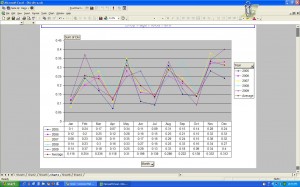The SPDR Dow Diamond ETF is an interesting candidate for a dividend capture strategy–if you can do it in a tax sheltered account such as a traditional or ROTH IRA. On an annual basis is it yielding around 2% and it distributes dividends monthly. Its dividend payouts are not consistent month to month, they vary from an average of $0.11 in January over the last 5 years, to and average of $0.33 in October. The chart below gives details. February’s average payout is around $0.25, which is pretty close to a .25% return since the DIA is around $100 per share right now.
DIA is unusual for a index ETF offering monthly dividends, in that its ex-dividend dates are the day before the option expiration date for that month. For example DIA goes ex-dividend on 19-February and the last day of trading on the options is also the 19th with expiration on Saturday the 20th.
This arrangement sets up a straightforward dividend capture scheme using covered calls. You buy DIA and sell DIA ITM calls, with an extrinsic value (time value) of approximately the dividend value (historically about 0.25 for February). At closing today, with DIA at $101.5, this would suggest the 98 Feb call, which at $3.75 would give the target extrinsic value. The break-even point on this position will probably be 101.5-3.75 =97.75. I say probably, because there is uncertainty on whether you collect the 0.25 per share dividend or not.
If DIA stays above 98.5, the 98 calls will almost certainly be assigned on the evening of the 18th–you won’t collect the dividend, but you will pocket the $.25 premium of your covered call position.
If DIA closes close to 98 on the 18th you may be assigned–but if the extrinsic value of the option is equal or greater than the dividend value then the call holder will probably not assign your options, and you will collect the dividend. Since you are right around the strike price of 98, your odds of having your options assigned at expiration after one more day of trading will be about 50% .
If DIA closes at 97.75 or lower, you will almost certainly collect the dividend, which lowers your break even point to around 97.5. If you are lucky, DIA would close that Friday at 98 or higher, giving you the maximum possible profit on the position of $0.5 per share. Unlucky–you start losing money below 97.5.
If it appears that your 98 options may expire worthless, then you need to think about whether you want to close out your long DIA position before the options expire. If your DIA does not get assigned then you are exposed to the normal variations in DIA’s price, beginning the Monday after, which could quite easily wipe out your .50 per share maximum possible profit. To close out that Friday is easy, “unwinding” the covered call is a straight forward process–if DIA is trading right around the strike price you might have to pay around .25 per contract, but you just got the dividend, so you are still ok. If DIA is below 97.5 then you are showing a loss and you are facing a tough call whether to cut and run, or hope for a market rebound.
Doing dividend capture with this deep ITM covered call approach gives you a substantial insurance policy on collecting close to the dividend amount. With only 7 days to go on the February calls you can take a 3.7% drop in DIA (3.75/101.5), collect your $0.25 / share, and hit your profit goal–not many bullish strategies can still pay off with that much of a drop-off.
One final scenario, if DIA staged a big run-up, right after you take the covered call position you would be able to close out the position sooner with most of the profit. There is no point in waiting because your calls will be assigned the night before the equity goes ex-dividend.
The thing I don’t like about this play, is that the high probability .25% payout is pretty meager incentive for taking any sort of risk. The best case .5% payout is an unlikely scenario you shouldn’t plan on. The silver lining is that you get this return with only 7 days of exposure/investment — one quarter of the exposure if you just buy and hold DIA. Of course you can juice up the return by selling options with higher strike prices–but then you are taking on significantly more risk.
From a tax standpoint the option profit would be ordinary income and the dividend if collected would be non-qualified, so if can’t do this in a tax protected account the net result is probably not worth it.


Click here to leave a comment